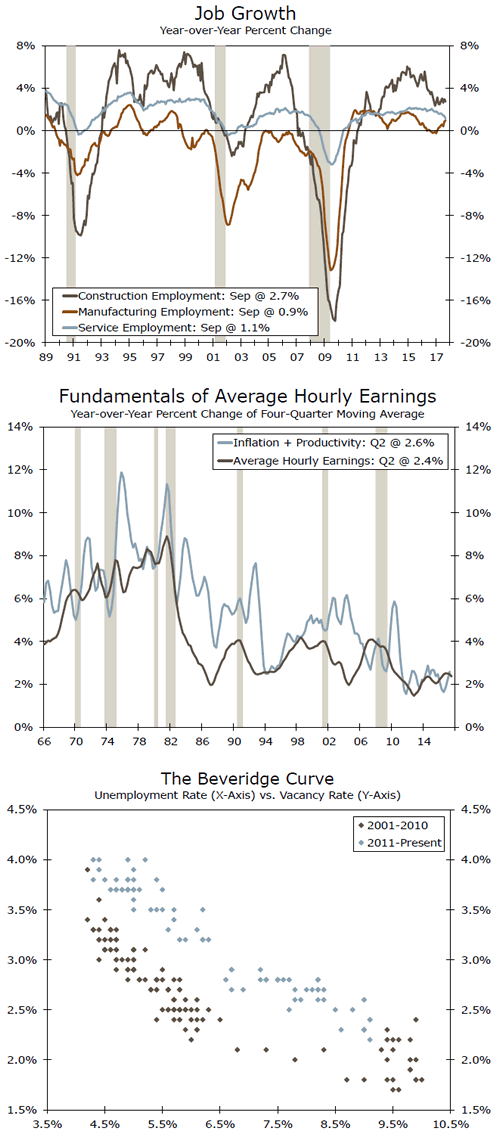Quickly moving beyond the temporary distortions, the outlook for jobs/personal income/consumer spending remains optimistic. The Fed still has the green light in December, even as jobs fell 33,000 in September.
September Jobs Down 33,000: Hurricane Whirlwinds
Nonfarm payrolls fell 33,000 in September, with the three month average slipping to 148,000 jobs. Despite the weakness, job gains in recent months and uptrend in wages are good for consumer incomes and consistent with 2.5 percent economic growth in the third quarter, and Fed policy as currently projected for a December rate hike.
Over time hiring in the services sector remains solid (top graph). In the goods sector, manufacturing and construction employment have continued to show gains over the past four years in contrast to the volatility witnessed, especially in manufacturing jobs, in the prior two expansions. Also reassuring has been the strength in the employment components of both the ISM manufacturing and non-manufacturing surveys this year.
Wage Growth: Real Wage Gains Over the Past Two Years?
Despite the focus on nominal wage gains, the real story for the American household is that real wages continue to rise and thereby boost household real incomes and consumer spending.
Nominal average hourly earnings rose 0.5 percent in September and are up 2.9 percent over the year. We interpret this gain as a shift in the mix of jobs where lower wage leisure and hospitality workers fell 111,000 in September. While job growth remains strong, the gradual rise in earnings over the past six months signals higher incomes but also pressure on profits as firms have modest top-line pricing power (especially in the goods sector).
Longer term, the modest inflation readings and weak productivity numbers have limited the gains in nominal wage growth (middle graph). Lackluster productivity growth in the current cycle has weighed on wage growth and will likely continue to hamper wage appreciation. Moreover, inflation has been persistently below the FOMC’s target of two percent and has struggled to sustain upward momentum. With both productivity growth and inflation continuing to prove sluggish, it is not altogether surprising that wage growth has disappointed given the performance of the fundamentals.
Structural Problems Persist: Drag on Growth
For any given unemployment rate (labor supply), the vacancy rate (job openings) remains wider than in the previous expansion (bottom graph), however the slack is gradually tightening. This Beveridge Curve signals a structural weakness in the labor market which is confirmed by several labor market survey indicators. Compared to a year ago, the unemployment rate for those without a high school education and with a high school diploma remains higher than the unemployment rate for those with some college.
The mean duration of unemployment rate remains at 24.4 weeks which is higher than any level since 1982. Finally, the prime age labor force participation rate has risen over the last year but remains far below the level of participation since 1990.














